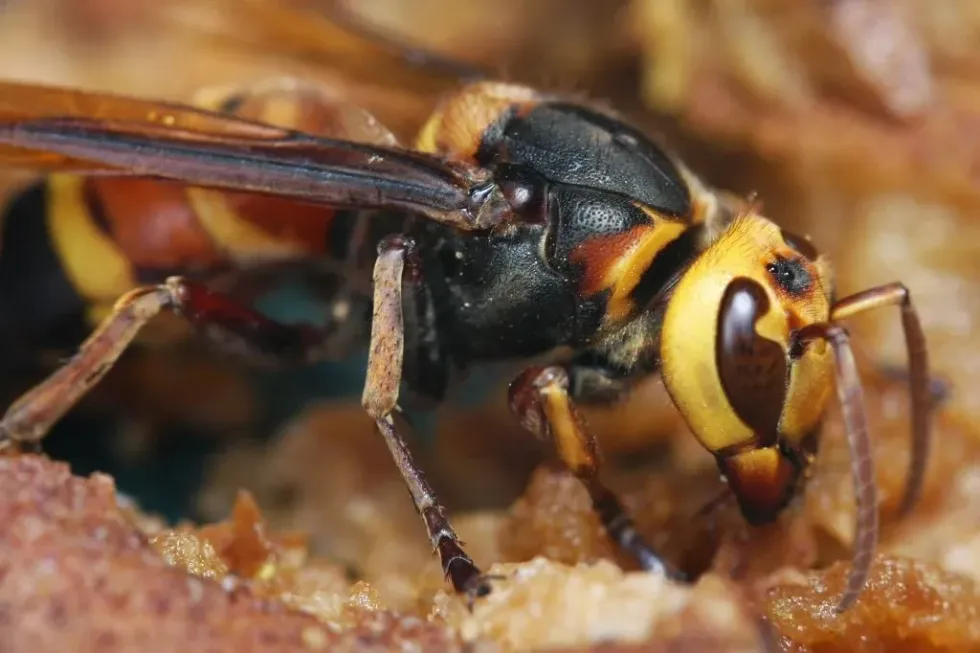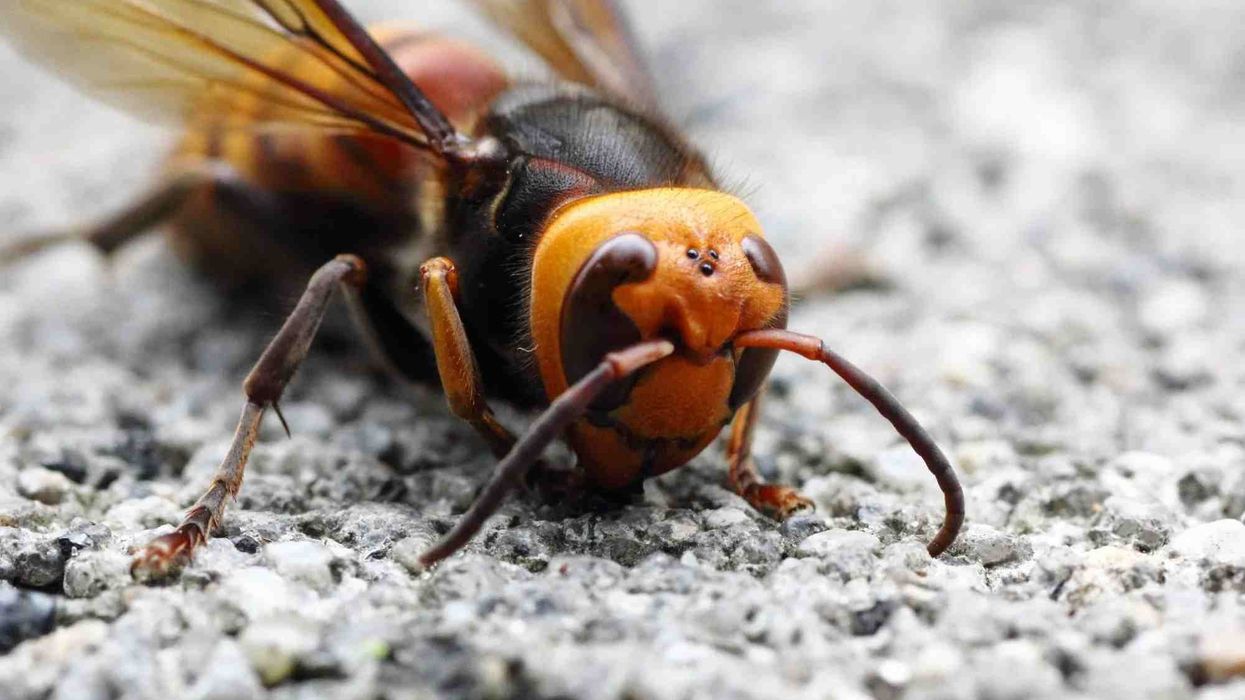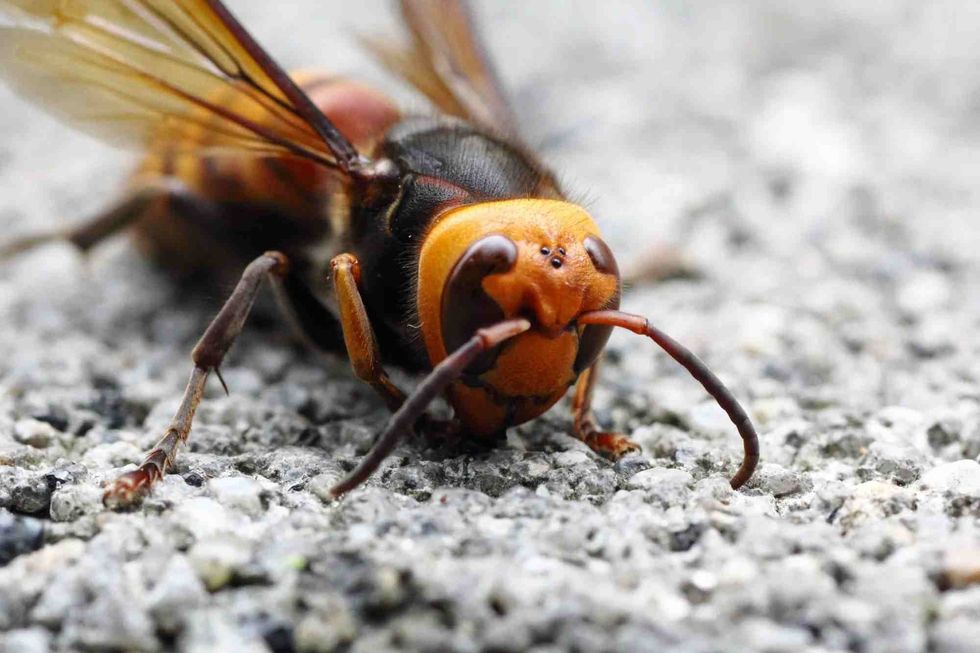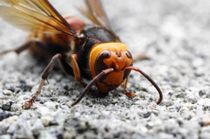Fun Asian Giant Hornet Facts For Kids

Content
- What type of animal is an Asian giant hornet?
- What class of animal does an Asian giant hornet belong to?
- How many Asian giant hornets are there in the world?
- Where does an Asian giant hornet live?
- What is an Asian giant hornet's habitat?
- Who do Asian giant hornets live with?
- How long does an Asian giant hornet live?
- How do they reproduce?
- What is their conservation status?
- What do Asian giant hornets look like?
- How cute are they?
- How do they communicate?
- How big is an Asian giant hornet?
- How fast can Asian giant hornets move?
- How much does an Asian giant hornet weigh?
- What are the male and female names of the species?
- What would you call a baby Asian giant hornet?
- What do they eat?
- Are they harmful?
- Would they make a good pet?
- Did you know...
- European hornet vs Asian giant hornet
- How to get rid of Asian giant hornets?
The year 2020 incorporates a lot of bizarre events and we also came across the term ‘Murder hornets’ which made headlines amidst the pandemic. Hornets are common in Asia, Europe, and North America and it is the largest of the social wasps.
Nevertheless, even before they created headlines, these Murder hornets existed as Asian giant hornets.
As the name suggests it is an inhabitant of East Asia but recently it can be found in North America too. The specialty of this hornet is that it is the world’s largest wasp species.
Other hornet species such as the Oriental hornet, Asian hornet, and European hornet are frequently confused with the Asian giant hornet, however, the latter possesses unavoidable aspects other than its size. Asian giant hornets are true hornets as they belong to the genus Vespa that incorporates all the true hornets.
There were three recognized subspecies of the Asian giant hornets V. mandarinia, V. nobilis, and V. magnifica.
However, they all were removed as their subspecies in 2020. These hornets are also considered an invasive species because they can jeopardize the colonies of honey bees and their conservation status is also not confirmed.
Intrigued already? Want to learn more about the Asian giant hornets? Then keep reading this article as more interesting facts are stated below.
Asian Giant Hornet Interesting Facts
What type of animal is an Asian giant hornet?
The world’s largest wasp species, the Asian giant hornet, is also referred to as the Japanese giant hornet. It is contemplated as an invasive species in North America and popularly called murder hornets.
What class of animal does an Asian giant hornet belong to?
The Asian giant hornet, or Vespa mandarinia, belongs to the class Insecta, order Hymenoptera, family Vespidae, and genus Vespa. All the hornets under the genus Vespa are true hornets. Once the Asian giant hornet had three subspecies but all of them have been discarded.
How many Asian giant hornets are there in the world?
The Asian giant hornet is an invasive species. It hails from Asia primarily where it is found in abundant the range of these covers as far as east Russia and now even in North America. Despite its wide range, the total number of these wasps present in the world is not evaluated.
Where does an Asian giant hornet live?
The geographical range of this wasp species is vast. It is a native species that inhabit southeast and east Asia predominantly.
It is also found in mainland Southeast Asia and far east Russia. In Japan, it is very widespread particularly in pastoral areas with an immense tree to form their hive.
In Japan, Asian giant hornets are referred to as giant sparrow bees. Besides Japan, Asian giant hornets can be found in Korea where they are called general officer hornets, and in Taiwan, they are called giant tiger head bees.
An Asian giant hornet's nest can also be found in countries like Laos, Cambodia, Thailand, Vietnam, Myanmar and even in regions of India, Nepal, and Sri Lanka. In 2019-2020 after it made headlines in the news it was found that the Asia giant hornets were found in North America too.
The sighting and nest were first confirmed in Vancouver, British Columbia. However, the Asian giant hornet was first observed in the USA in the neighboring area of Washington state.
What is an Asian giant hornet's habitat?
The Asian giant hornet's habitat is predominantly forests, or rural areas, and even mountainous regions. It is absent in extreme urban areas, and even in the higher altitudes.
The lowlands forest and lower foothills provide them with an ideal condition to thrive in their subterranean nests. The Asian giant hornet nest is either already created by burrowing animals, rodents or they build it that has a depth of 2-24 in (6-60 cm).
These are different stages of creating and combining the combs and merging them into one nest. The nests of this species consist of at least four to seven combs.
Who do Asian giant hornets live with?
The Asian giant hornet is a social species and prefers living in a colony or swarm. The colonies of hornets consist of queens, workers, drones, and Asian giant hornet larvae.
The colony of the eusocial wasps and hornets consists of six distinct phases. The queens are usually the largest and reproduce. The workers and the drones are of the same size but the stinger is absent in the drones.
How long does an Asian giant hornet live?
The average lifespan of the Asian giant hornet is not very long, the queen can live for almost one year. The males, or drones, die shortly after mating, while the lifespan of workers is between spring and winter. After the breeding season, the queen constructs the colonies during spring and then dies in winter.
How do they reproduce?
The Asian giant hornet is a species of social wasp and thus has a social hierarchy based on its ability to reproduce. Besides the presence of queens, the colonies consist of workers, and drones (males).
The breeding season of the Asian giant hornet is during fall and only the queen can reproduce. The process is initiated by the release of pheromones that attracts the drones.
Mating occurs in front of the nest after the male seizes the queen when she is about to leave the nest. Copulation can last anywhere between 8-45 seconds on the ground.
After copulation, the queen undergoes hibernation which is also the first phase of the colony cycle. After hibernation that ends by mid-April the fertilized queen searches for a nest while the uninseminated queen doesn’t.
Once the queen finds a nest she lays at least 40 eggs that become the workers.
However, until July the workers refrain to work outside the hive. The queen also partakes in activities until the middle of July.
By the end of summer, thousands of eggs are additionally reproduced by the queen out of which the fertilized eggs become new queens for the following season and the unfertilized eggs become males.
Therefore, the Asian giant hornet maintains a sequence where the queen takes care of the workers initially, and later the worker takes care of the new queens and males.
After the queen dies, males and the new queen take the initiative to continue the process of reproduction. This large hornet maintains an advanced degree of colonial spirit.
What is their conservation status?
The conservation status of the Asian giant hornet is Not Evaluated by the IUCN. However, numerous measures have been taken to keep their population under control because this species can cause plenty of damage. Some of the extermination methods may include mass poisoning, bait trap, nest removal, and many more.
Asian Giant Hornet Fun Facts
What do Asian giant hornets look like?

The Asian giant hornet is referred to as having different names in a different region but particularly they are acknowledged for their size. They are wasps of large size living in colonies consisting of the Asian giant hornet queen, workers, and drones.
The size of the variety as the queen is the largest of all and can surpass 2.1 in (5.5 cm).
The workers and drones have a similar size which is around 1.4-1.6 in (3.5-4 cm) respectively. Although the queen and the workers have similar reproductive anatomy, it is only the queen who reproduces.
Besides size, they do not have many dissimilarities as the head of the hornet is light orange and has two antennas. These antennas are brown or black and their base is orange-yellow.
The Asian giant hornets have eyespot that can be black or brown. As they are subterranean they have a black tooth attached to their mandible to enable digging.
The major part of its abdomen region has alternate black or dark brown and orange or yellow band while its sixth section is yellow.
The workers have stingers and, like every other wasp, this species of hornet also stings moreover it contains strong venom. The Asian giant hornets have two pairs of wings that are grey and their forelegs are brighter than their hind legs.
How cute are they?
These types of wasps are large and extremely predatory and therefore not cute.
How do they communicate?
There are various methods of communication acquired by both the larvae and the adults. The larvae rub their mandibles against the hive wall to signify that they are hungry.
Adult hornets use pheromones and visual clues to fly. Primarily it is the scent marking that enables the hornets to mark a bee colony and attack it. Just like the larvae the adult hornets also click their mandibles as a warning.
How big is an Asian giant hornet?
The Asian giant hornet size is large it is approximately 2.1 in (5.5 cm). It is bigger than the bald-faced hornet, which is 0.70-0.78 in (1.7-1.9 cm).
How fast can Asian giant hornets move?
The speed of the Asian giant hornet is 25 mph (40 kph). These species of wasp can fly 0.6-1.25 mi (1-2 km) from their hive and sometimes can cover even 5 mi (8 km).
How much does an Asian giant hornet weigh?
The weight of the Asian giant hornet is not listed. The queen is large while the workers and drones are not as big as the queen.
What are the male and female names of the species?
The nest consists of a queen who is female and reproduces, the workers are also females who never mate and take care of the new queens and drones. The males are born from unfertilized eggs and are referred to as drones.
What would you call a baby Asian giant hornet?
The babies of Asian giant hornets are called larvae. After copulation, the queen initially lays around 40 eggs that become workers, and later she lays thousands of eggs. The young are taken care of by the workers who feed them a paste made out of their prey that primarily includes honey bees.
What do they eat?
Asian giant hornets are known for their extremely predatory nature. The diet of this species consists of small insects, other hornets, and honey bees. Foraging is done by the workers who even take down large insects such as the mantises and even crop pests sometimes.
Are they harmful?
Yes, Asian giant hornets are extremely predatory, territorial, and harmful. They may attack in groups and their attack can be divided into distinct stages.
The first stage is called the hunting stage as the hornets wait outside the beehive waiting for a potential prey which they can attack turn into a paste and take it to feed the larvae.
The second phase is called the slaughter phase as they do not wait for a single prey instead they mark an entire nest or colony. The slaughter phase involves at least two to 50 hornets who wait outside the nests of the honey bees or other hornets and counterattack the prey.
It is easier for them to take down honey bees than other hornets.
The attack continues till the Giant Asian hornet takes over the nest which is the third phase. After occupying the new nest, these hornets become extremely territorial and do not let any other animal come close to the nest.
Would they make a good pet?
No, their sting is dangerous therefore it cannot be kept as a pet.
Did you know...
Certain mountain villages in Japan excavate the nests of these hornets as their larvae are considered a delicacy and the adults are fried until they become crunchy.
Multiple wasp stings can kill human beings, and in Japan, around 40-50 people are killed by the Asian giant hornet each year.
European hornet vs Asian giant hornet
The European hornet and the Asian giant hornet are both true hornets of a similar genus, nevertheless, both of them have distinguishing features. The Asian giant hornet is the largest of all, while the European hornet is not as big as the former and its queen is around 1-1.3 in (25-35 mm).
The head of the Asian giant hornet is primarily yellow or orange but the European hornet is reddish-brown.
The strips of the Asian giant hornet are devoid of any accent while the Europen hornets have teardrop accents. The eyes of the Asian giant hornet are comparatively smaller than the European hornet.
How to get rid of Asian giant hornets?
Several methods can be ventured to get rid of the Asian giant hornets as for Japan itself there are six different ways to control them.
Beating the hornets with a flat-headed wooden stick is one way to get rid of them as they do not attack while hunting bees or their hive. However, the major disadvantage of this method is that it is very time-consuming.
Next is the nest removal where the nests are put on fire at night to eliminate the entire colony.
Then there is mass poisoning which is done by feeding them bees or sugar solution containing malathion which is a poisonous substance.
Bait trapping is another method that can be done by luring the hornets into a system that contains honey bees. The honey bees can escape from the one-side mesh opening but the hornets which once get it cannot escape from the mesh opening as they are bigger than the honey bees.
Protective screens can also be used to get rid of the hornets however, the idea of a protective screen works more efficiently when combined with bait traps.
Here at Kidadl, we have carefully created lots of interesting family-friendly animal facts for everyone to discover! Learn more about some other arthropods from our atlas beetle facts and click beetle facts pages.
You can even occupy yourself at home by coloring in one of our free printable hornet color
We Want Your Photos!
More for You
Bachelor of Arts specializing in Journalism and Mass Communication, Postgraduate Diploma in Sports Management

Moumita DuttaBachelor of Arts specializing in Journalism and Mass Communication, Postgraduate Diploma in Sports Management
A content writer and editor with a passion for sports, Moumita has honed her skills in producing compelling match reports and stories about sporting heroes. She holds a degree in Journalism and Mass Communication from the Indian Institute of Social Welfare and Business Management, Calcutta University, alongside a postgraduate diploma in Sports Management.
Disclaimer
1) Kidadl is independent and to make our service free to you the reader we are supported by advertising. We hope you love our recommendations for products and services! What we suggest is selected independently by the Kidadl team. If you purchase using the Buy Now button we may earn a small commission. This does not influence our choices. Prices are correct and items are available at the time the article was published but we cannot guarantee that on the time of reading. Please note that Kidadl is a participant in the Amazon Services LLC Associates Program, an affiliate advertising program designed to provide a means for sites to earn advertising fees by advertising and linking to Amazon. We also link to other websites, but are not responsible for their content.
2) At Kidadl, we strive to recommend the very best activities and events. We will always aim to give you accurate information at the date of publication - however, information does change, so it’s important you do your own research, double-check and make the decision that is right for your family. We recognise that not all activities and ideas are appropriate for all children and families or in all circumstances. Our recommended activities are based on age but these are a guide. We recommend that these ideas are used as inspiration, that ideas are undertaken with appropriate adult supervision, and that each adult uses their own discretion and knowledge of their children to consider the safety and suitability. Kidadl cannot accept liability for the execution of these ideas, and parental supervision is advised at all times, as safety is paramount. Anyone using the information provided by Kidadl does so at their own risk and we can not accept liability if things go wrong.
3) Because we are an educational resource, we have quotes and facts about a range of historical and modern figures. We do not endorse the actions of or rhetoric of all the people included in these collections, but we think they are important for growing minds to learn about under the guidance of parents or guardians.







